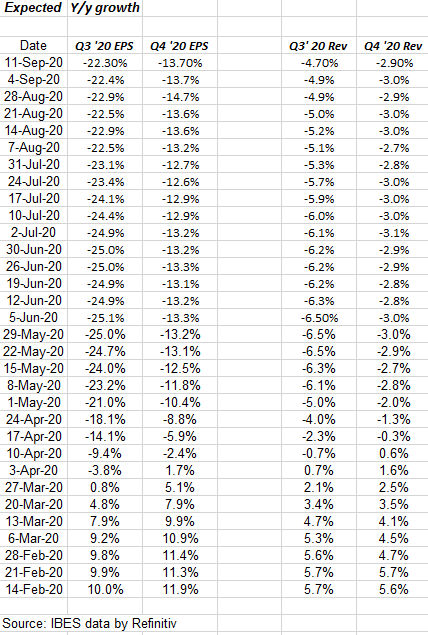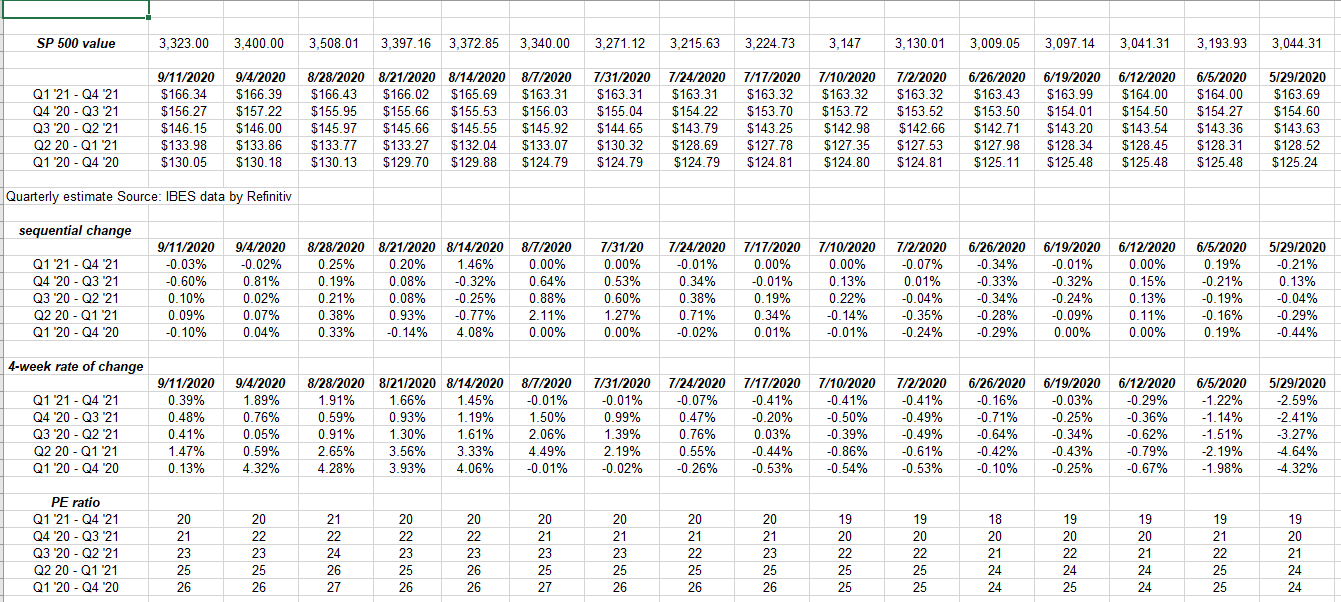Each week, when the core IBES data by Refinitiv is dropped into the spreadsheets, I try and think about which of the datasets is most meaningful.
This week, this table wasn’t what was expected:

The expected y/y revenue growth for Q3 and Q4 ’20 is still improving as we approach the quarters highlighted.
Forward S&P 500 earnings curve:
On the flip side, what worries me a little bit is that for the S&P 500 forward earnings curve, the “4-week rate of change” is starting to slow:

Note the data under the “4-week rate of change” and how the rate of change is slowing.
The better news is the “sequential increases” are still occurring.
Some of this is a typical end of quarter stuff. The revisions tend to get worse as the quarter-end approaches.
S&P 500 EPS summary:
- Forward 4-qtr estimate this week was $146.15 vs last week’s $146, the 10th sequential increase in the last 11 weeks;
- The forward PE is 22.8x versus last week’s 23.3x
- The S&P 500 earnings yield has risen for the third straight week to 4.38%, which in absolute terms is still a little low;
- For 22 consecutive weeks, the “average” expected S&P 500 EPS growth rate for 2020 and 2021 is still 4%;

The table of data above shows the 1-year y/y change of the S&P 500 forward 4-qtr EPS estimate, as well as the sequential increases since July 2nd.
Readers can see the improvement in the 1-year y/y change in the forward estimate from it’s bottom on June 5th.
Summary / conclusion:
Listening to Josh Brown and Morgan Housel discuss Morgan’s new book, “The Psychology of Money” on Josh’s podcast this week was well worth the 30 minutes. Josh talked about bloggers and those bloggers who get too technical and “wonky” with their work (contrasting this with Morgan’s book) and I thought about this weekly S&P 500 earnings update on this blog and it’s inherent geekiness with all the data and the “rate of change”, etc. but writing this blog every week imposes discipline to keep the spreadsheets updated and to make sure I’m looking at IBES data by Refinitiv regularly.
It’s like doing 100 sit-ups a day – there might be sexier exercises, but if that’s what you can do, and that’s what keeps you focused, then it’s better to do that, than not. (By the way, this isn’t a criticism of RWM or Josh, not that he’d probably care, but exactly the opposite, there is probably no more thought-provoking collect of writers and market commentators than at Ritholtz, with Josh, Ben Carson, Morgan Housel and Michael Batnick, than any other small or even larger asset management firm. They have really elevated the idea of social media mind share, with all the content produced for the average investor, that is digestible and understandable for all. )
While I’d like to see the S&P 500 earnings yield start continue to improve, it will probably only do so when the S&P 500 weakens and S&P 500 EPS starts to improve. While a combination of those two occurrences are somewhat “mutually exclusive” statistically speaking, we are seeing that right now in September ’20 as the SP 500 weakens and the SP 500 forward estimate continues to improve weekly.
Bottom line: nothing has changed with the S&P 500 earnings written about here the last few months, that S&P 500 earnings and revenue estimates were likely reduced too much in Q2 ’20 and are now being revised higher as we move through Q3 ’20.
I’ve seen some Q3 ’20 GDP estimates as high as 25%, which is still a net negative of -7% for a combination of Q2 and Q3 ’20 GDP, but this market definitely feels different than your “average” 7% GDP contraction.
Remember, take all this data and the opinions herein with considerable skepticism. Do your own homework, and evaluate all market-related information in light of your own financial condition and time horizon.
The 4-week rate of change and the rest of the data will be updated again next week.
